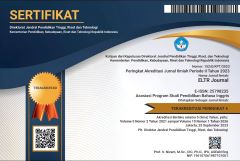COMMUNICATIVE MOVES IN THE DISCUSSION SECTIONS OF EFL INDONESIAN VOCATIONAL COLLEGE STUDENTS
Abstrak terlihat: 316 / PDF terunduh: 353DOI:
https://doi.org/10.37147/eltr.v7i1.167Keywords:
academic writing, communicative move, discussion sectionAbstract
Studies on the move analysis in the various sections of research articles have developed rapidly. However, the studies on the communicative moves in the discussion section particularly written by vocational college students are still limited. In fact, those students categorized as the novice writers inevitably need illustrations of how to write the proper discussion related to their findings. Therefore, this study was aimed at exploring the communicative moves and the move cycle series in the discussion sections of the final project reports written by EFL vocational college students in one of the state polytechnics in Indonesia. The method used is a discourse analysis on 15 discussion sections. The results showed that Move II, Move IV, and Move I were used frequently in all students’ discussion sections. Pertaining to the move cycle series, students fulfilled the rhetorical functions of introduction (1) and evaluation (4+2 or 2+4) but the cycle for showing the conclusion was commonly not used. The results provide references and the real applications pertinent to communication moves in the discussion section by EFL students.
Downloads
References
Amnuai, W. (2019). Analyses of rhetorical moves and linguistic realizations in accounting research article abstracts published in international and Thai-based journals. Sage open, 9(1), 1-9. https://doi.org/10.1177/2158244018822384
Asari, S., Kurnia, F.D., & Suharsono S. (2018). Ideas pattern manifested in rhetorical moves of English Language teaching and learning research articles discussion written by Indonesian English academics. ELite Journal: International Journal of Education, Language, and Literature, 1(1), 83-92.
Dudley-Evans, T. (1994). Genre analysis: An approach to text analysis for ESP. In M. Coulthard (Ed.), Advances in written text analysis (pp. 219–228). London: Routledge.
Holmes, R. (1997). Genre analysis, and the social sciences: An investigation of the structure of research article discussion sections in three disciplines. English for Specific Purposes, 16(4), 321-337.
Indrian, R. D., & Ardi, P. (2019). Rhetorical structures of English-major undergraduate thesis introduction chapters. Indonesian Journal of EFL and Linguistics, 4(2), 195-214.
Irawati, L. (2022). Potential factors influencing the rhetorical patterns of research article discussion sections. Studies in English Language and Education, 9(1), 115-131.
Jurusan Administrasi Bisnis. (2020). Panduan praktik kerja lapangan dan tugas akhir. Madiun: Politeknik Negeri Madiun.
Le, T.N.P., & Harrington, M. (2015). Phraseology used to comment on results in the Discussion section of applied linguistics quantitative research articles. English for Specific Purposes, 39, 45-61. http://dx.doi.org/10.1016/j.esp.2015.03.003
Lewin, B.A., Fine, J., & Young, L. (2001). Expository discourse: A genre-based approach to social science research texts. New York: Continuum
Li, X. (2020). Mediating cross-cultural differences in research article rhetorical moves in academic translation: A pilot corpus-based study of abstracts. Lingua, 238, 1-11. https://doi.org/10.1016/j.lingua.2020.102795
Liu, Y., & Buckingham, L. (2018). The schematic structure of discussion sections in applied linguistics and the distribution of metadiscourse markers. Journal of English for Academic Purposes, 34, 97-109. https://doi.org/10.1016/j.jeap.2018.04.002
Loan, N.T.T, & Pramoolsook, I. (2015). Move analysis of results-discussion chapters in TESOL master’s theses written by Vietnamese students. 3L: The Southeast Asian Journal of English Language Studies, 21(2), 1-15
Lu, X., Casal, J. E., & Liu, Y. (2020). The rhetorical functions of syntactically complex sentences in social science research article introductions. Journal of English for Academic Purposes, 44, 1-16. https://doi.org/10.1016/j.jeap.2019.100832
Peacock, M. (2002). Communicative moves in the discussion section of research articles. System, 30, 479-497.
Rahayu, T., Permatasari, I., Mudofir, I., Sutantohadi, A., & Maftuh, M.F. (2022) Rhetorical moves in the background sections of EFL Indonesian vocational college students. LLT Journal, 25(20), 660-670. https://doi.org/10.24071/llt.v25i2.4273
Rashidi, N., & Meihami, H. (2018). Informetrics of Scientometrics abstracts: A rhetorical move analysis of the research abstracts published in Scientometrics journal. Scientometrics, 116, 1975–1994. https://doi.org/10.1007/s11192-018-2795-6
Ruiying, Y., & Allison, D. (2003). Research articles in applied linguistics: Moving from results to conclusions. English for Specific Purposes, 22(4), 365-385. https://doi.org/10.1016/S0889-4906(02)00026-1
?anl?, Ö., Erdem, S., & Tefik, T. (2013). How to write a discussion section?. Turkish Journal of Urology, 39, 20-24.
Saricaoglu, A., Bilki, Z., & Plakans, L. (2021). Syntactic complexity in learner-generated research paper introductions: Rhetorical functions and level of move/step realization. Journal of English for Academic Purposes, 53, 1-11. https://doi.org/10.1016/j.jeap.2021.101037
Swales, J. M. (1990). Genre analysis: English in academic and research settings. Cambridge: Cambridge University Press
Suherdi, D., Kurniawan, E., & Lubis, A. H. (2020). A genre analysis of research article ‘findings and discussion’ sections written by Indonesian undergraduate EFL students. Indonesian Journal of Applied Linguistics, 10(1), 59-72. https://doi.org/10.17509/ijal.v10i1.24989
Tanko, G. (2017). Literary research article abstracts: An analysis of rhetorical moves and their linguistic realizations. Journal of English for Academic Purposes, 27, 42-55.
Tocalo, A.W.I. (2021). Move structures and their rhetorical verbs of research article abstracts across Englishes. Indonesian Journal of Applied Linguistics, 11(1), 1-10. https://doi.org/10.17509/ijal.v11i1.34593
Warsito, W., Syah, S. A., & Harahap, A. (2017). Stating and defending new knowledge claim: a rhetorical analysis on the discussion section of English master thesis by Indonesian EFL learners. IJEE (Indonesian Journal of English Education), 4(2), 188-207. http://dx.doi.org/10.15408/ijee.v4i2.6746
Yang, R., & Allison, D. (2003). Research articles in applied linguistics: Moving from results to conclusions. English for Specific Purposes, 22, 365-385.
Downloads
Published
How to Cite
Issue
Section
License
Copyright (c) 2022 Titik Rahayu, Muhyiddin Aziz, Moh. Farid Maftuh

This work is licensed under a Creative Commons Attribution-ShareAlike 4.0 International License.













